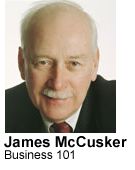 |
|
|
YOUR
COUNTY.
|
YOUR
BUSINESS JOURNAL.
|
Published October 2004
Get
new perspective
by ‘thinking inside the box’
 One
of the most popular business cliches today is “thinking outside the box.”
It is a good idea, of course, when you need a creative solution to a problem,
or, even better, when you need a solution to a problem you haven’t even
identified yet.
One
of the most popular business cliches today is “thinking outside the box.”
It is a good idea, of course, when you need a creative solution to a problem,
or, even better, when you need a solution to a problem you haven’t even
identified yet.
Still, there is something to be said for “thinking inside the box” — that is, using square footage, or number of workers — to get some perspective on such things as profitability, productivity and product selection. While there are possibly some businesses that operate entirely in virtual space, most enterprises operate with real people in some physical location (“the box”).
Thinking inside the box involves the use of “common denominators,” and they are very helpful in analyzing your own business, or in making comparisons between one business and another. These common denominators come in two general forms: financial and operational.
The financial common denominators have a long history and include such basic things as ROA (return on assets) and current ratio (liquidity), as well as more complex and special-purpose ratios. They are well known by business managers, investors and lenders.
They tell only a part of a company’s story, though. Less well known are some of the operational common denominators that analysts, and business managers, can use to evaluate performance and spot trends that need management attention.
Certainly one of the oldest of these is one of the most valuable, yet very simple and straightforward: sales, or operating revenue, per worker. It is remarkable how often this simple fraction can identify a problem or explain the mystery of shrinking profits. Any business with even a trace of survival instinct should be looking at this simple common denominator on a regular basis — at least once a year.
In order to use sales-per-worker or revenue-per-worker, we have to know how many workers we have, and adding them up involves something called the full-time equivalent (FTE).
In most measurement systems, an eight-hour day, five-day week is used as the FTE standard — that is, everybody who does this counts as 1.0 FTE. A half-time person, somebody who helps out during the busy morning shift of four hours, for example, would count as 0.5 FTE.
Another standard that is used is the 2,000-hour year, because this allows us to deal statistically with workers who, for some reason, weren’t on the job for the full year. If they worked full time for 10 weeks, then they would count as 0.20 FTE (400 divided by 2,000).
A similar approach can be taken with overtime. If someone works a total of 180 hours overtime during the course of the year, we would assign to him or her an FTE value of 1.09 (2,180 divided by 2,000).
While there is general agreement among business analysts on the ways to use FTE calculations to handle hourly workers, there is no such consensus on what to do with salaried people — the managerial, supervisory, sales, technical and other professional staffers. Probably the best thing for business managers to do is to look at FTEs both ways — hourly only and total hourly and salaried — and compare the results.
If sales or revenue per FTE is declining, it is very important for us to find out why. It could be that the market is simply going through a soft patch. It happens. But if your sales are going up and sales-per-FTE is going the other way, it may be that:
- The market structure is shifting and more service is required per dollar of sales.
- Your backroom, or in-house, costs are going up for some good, or bad, reason.
- You simply aren’t managing and motivating our workers as effectively as you used to.
There are other possible explanations, too, and tracking down the real reason is part of the fun of managing a business.
Another useful operational common denominator is revenue-per-square-foot of space leased or owned. We see this measure most frequently in retail businesses — and it is usually part of any investment analysis of the larger firms, but smaller business of all types can put it to good use, too.
What we learn from the revenue-per-square-foot number is whether we are making effective use of our physical facility. And here, if the number is declining the likely suspects are product mix, operational efficiency and, in some businesses, inventory management.
Operational common denominators that measure our productivity on a per-worker or per-square-foot basis can be, and often have to be, tailored to a specific business. But whether we use them “out of the can” or customize them, operational common denominators often detect trends in a business before they show up clearly on our financial statements. And for managers, that’s a good thing.
James McCusker, a Bothell economist, educator and small-business consultant, writes “Your Business” in The Herald each Sunday. He can be reached by sending e-mail to otisrep@aol.com.
© 2004 The Daily Herald Co., Everett, WA








